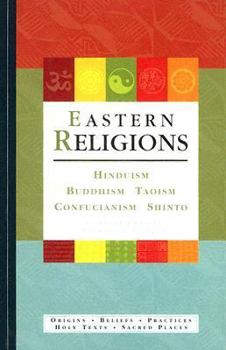Eastern Religions: Hinduism, Buddhism, Taoism, Confucianism, Shinto
Select Format
Select Condition 
Book Overview
This fascinating volume provides a concise, illustrated introduction to five of the great religious traditions of the world--Buddhism, Hinduism, Taoism, Confucianism, and Shinto. Buddhism, one of the world's great religious traditions, attracts millions of modern-day followers. Hinduism, one of the most ancient of all belief systems, is increasingly well known in the West through expatriate Indian communities. Taoism has been an important influence on Western thinking, especially through the impact of the Tao Te Ching. Confucianism, less metaphysical in its principles, emphasizes family values and the role of the individual within the state. And Shinto, distinctively Japanese in character, is the most animistic of the great religions, based on a belief in numerous individual spirits. The contributors explore a great variety of topics within these religions, including: the life of the Buddha; karma and rebirth; inspiring teachers and gurus; the life of Confucius; sacred Taoist texts; the epics of the Ramayana and Mahabharata; holy landscapes, shrines, and festivals; enlightenment; and--for all the faiths--the spiritual and ethical teachings, art and architecture, sacred writings, ritual and ceremony, and death and the afterlife. Also included are extracts from or summaries of historical texts, with author commentaries that explain the significance of each piece and place in its full context. Authoritative and accessible, Eastern Religions provides a gateway for all those in the West who wish to move one step closer to the spirit of the East.
Format:Paperback
Language:English
ISBN:0195221915
ISBN13:9780195221916
Release Date:May 2005
Publisher:Oxford University Press, USA
Length:552 Pages
Weight:2.12 lbs.
Dimensions:1.5" x 5.7" x 7.4"
Customer Reviews
3 ratings
great
Published by Thriftbooks.com User , 15 years ago
I was extremely happy they expeditited this item for a low fee. Book was in good condition
nice :3
Published by Thriftbooks.com User , 16 years ago
Concise information, nice (and lots of) pictures, and NEVER boring! I really enjoyed using this book for my Eastern Humanities class. It was not at all what I had expected: it was not hard to understand, it was not boring, and it did assume that I already knew everything there was to know about Eastern religions. So, all-in-all, I would recommend this book... even if you're not taking an Eastern religion class! It really clarifies a lot of myths and misconceptions about Eastern religions.
an unusual introductory text
Published by Thriftbooks.com User , 19 years ago
This Oxford publication seems best suited for a comparative world religion course. I found it in search of material for a unit on comparative world religion in my Sociology of Religion course, and I have used it several times now. I wish there was something comparable on Western Religions! EASTERN RELIGIONS is unorthodox in that it has the glossy pages and color photos typically found in a large-format textbook, but instead is in a 5" X 7.5" handbook format. It is 550 pages long, but with plenty of great photos, including reproductions of artwork, the actual text is nowhere near that long. The organization of the sections is both the strength and the weakness. Hinduism, Buddhism, Taoism, Confucianism and Shinto are covered, and for each there is a section on 1) Origins and Historical Development, 2) Aspects of the Divine, 3) Sacred Texts, 4) Sacred Persons, 5) Ethical Principles, 6) Sacred Space, 7) Sacred Time, 8) Death and the Afterlife, and 9) Society and Religion. The strength of this approach, from a sociological standpoint, is that religious practices receive as much attention as religious doctrines and beliefs. For instance, Dipavali, the Necklace (or Festival) of Lights, which was recently celebrated, is covered in the Sacred Time sub-section of the Hinduism section. For instance Laozi, fabled author of the Tao te Ching, is worshipped as a god by Taoists in China, which I'm sure is news to many in the West who read the Tao te Ching as philosophy and are informed that Laozi may never have existed as a singular historical person at all. The reader learns of the Three Teachings tradition of China, which combines Confucianism, Taoism and Buddhism. Here's where the strength becomes a weakness, though -- the China expert has to write the Taoism and Confucianism sections separately, and so while some of the material overlaps (for instance qi, yin and yang), it remains unclear exactly how they are (or were) combined in the everyday life of the Chinese people, let alone how they combine with Buddhism which has a separate author altogether. And the Chinese "popular religion" is mentioned as well, but never explained at all, because it doesn't fit the framework. Credit where credit is due: the Hinduism section is written by Vasudha Narayanan, Professor of Religion at the University of Florida, the Buddhism section is written by Malcolm David Eckel, Associate Professor of Religion at Boston University, the Shinto section is written by C. Scott Littleton, Professor Emeritus of Anthropology at Occidental College in Los Angeles, and the sections on Taoism and Confucianism are written by Jennifer Oldstone-Moore, Assistant Professor (of what the book jacket does not say) at Wittenberg University in Ohio.






